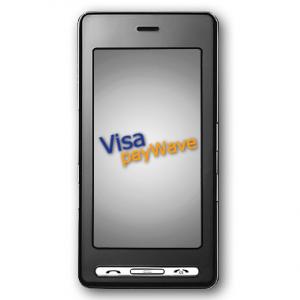BARCELONA – Visa Inc. will test contactless microSD cards with one or more banks during the second quarter, as it moves to satisfy what it said is “really high” demand from issuers for mobile-payment devices.
Visa today announced plans to market contactless microSDs carrying its payWave application, telling NFC Times the cards could serve as a bridge until the time NFC phones are available for contactless mobile payment. The card scheme made the announcement on the first day of the Mobile World Congress in Barcelona.
“We still expect NFC to be the long-term solution,” Dave Wentker, Visa's head of mobile contactless, told NFC Times, adding it is still an open question as to “how long is the bridge” to broad availability of NFC phones.
Visa will offer cards to issuers from U.S.-based DeviceFidelity, which said it has developed a working contactless microSD that can conduct payWave transactions in 150 to 350 milliseconds, the same amount of time it takes to pay with conventional payWave cards. Consumers would have to hold their phones carrying the microSDs at between 1.5 to 3 centimeters from readers. That’s closer than the roughly 4-centimeter range of conventional contactless bank cards. The payment application would be stored on secure chips embedded in the SDs.
Deepak Jain, DeviceFidelity CEO told NFC Times the cards embed a 3-millimeter-by-9-mm contactless antenna in the tiny flash-memory cards, which pull power partly from the phone and partly from the contactless reader to complete the transaction. The payWave application would have to be preloaded on the cards at present, but by mid-2010, Visa applications could be downloaded over the air to the cards inserted in the phones, he said.
Jain declined to say whether Visa is investing in the company, which last October disclosed it was awarded a $3 million grant from the state government in its home base of Texas. The company is a a 2007 startup.
The Visa announcement with DeviceFidelity issuers comes after NFC Times reported last week that large U.S. third-party processor First Data was to sign an agreement with another U.S.-based maker of contactless SD cards, Tyfone. First Data was expected to announce plans to introduce the contactless microSD cards in about a month, along with the launch of its new trusted service manager unit. First Data is also expected to invest in Tyfone.
First Data told NFC Times the unit would be able to download contactless payment applications from all the major brands, including Visa, among other payment applications, to the SD cards as well as to NFC phones. Its customers for the cards are expected to be banks and other payments service providers.
Interest is growing in general in contactless microSDs among these issuers, as they wait for NFC. Unlike passive contactless stickers, payment or other applications on the SD cards can link to mobile-wallet applications on the phones, giving the consumers a pleasing user interface.
The applications can also communicate with the network, which means issuers could download and manage them over the air through trusted service managers and also send promotions tied to the payment applications. “Putting a sticker on a mobile phone is not necessarily a mobile-payment device,” a Visa spokeswoman told NFC Times.
Still, the contactless microSDs have not yet been market tested. And while they work in most handsets with microSD slots, if the slots are behind the phone battery, the transmissions would be blocked. Many BlackBerry models have their slots in just such a location. And the popular Apple iPhone has no SD slot at all.
The issuing model for microSD payment cards is also open to question. Since the payment SDs can pack an additional 2 gigabytes of flash storage for such content as videos, music and documents, banks may not be a natural issuer. Consumers might buy them in electronics stores or from mobile carriers.
Visa's Wentker, when asked, denied that Visa’s planned introduction of microSD payment cards was a shot at mobile operators or intended as a way for banks to offer mobile payment without involving telcos.
“Carriers are a very natural distribution party; they’re the largest distributor of flash cards today,” Wentker told NFC Times. “(But) if you want to distribute this through a traditional (payment) card bureau, you can. If you want to do it over the air, you could also do that.”

 NFC TimesThe premier source for news, analysis and commentary on
NFC TimesThe premier source for news, analysis and commentary on 